According to a report released by Research and Markets, the global food and beverage (F&B) e-commerce market reached $22.4 billion in 2020. Due to the pandemic, people spend most of their time staying indoors, which leads to the increasing need for purchasing food and other essential products online. Such conditions create opportunities for people who want to learn how to sell food online from scratch or those who are making transition from offline to online.
With a wide range of e-commerce platforms, you now have many creative ways to build online stores. However, it will be much easier for you to follow the listed steps not to waste time roaming around. So, the guide below is everything you need. Let’s get started!
Check out other chapters curated for merchants making brick-to-click transition HERE.
I. Know the law
Selling edible products means you have to make sure your food is safe for consumers. Regulations and certifications required may seem a bit tricky at first, but they all help to guarantee your food’s standard and minimize the possibility of making your buyers sick.
01. General regulations for selling food
People who plan to sell food online in the United States Business need to follow the Cottage Food Laws (CFL), which applies to individuals, not businesses. However, it goes for small businesses in some cases like farms and home-based ones. While those laws are slightly different within states, there are some unchanged requirements that you should be aware of, including:
- You must undergo a yearly kitchen inspection conducted by the local health department.
- You need to obtain a zoning clearance/permits from the department of agriculture or health.
- A valid state business license is needed.
- The cooking place (kitchen) must be pet-free.
- Storage spaces, cold and dry, must meet sanitary regulations.
Whether it is your home kitchen or a commercial kitchen, make sure you are familiar with local rules for food and beverage. In case your food comes from a supplier, it is requisite to check the supply chain to ensure its standard. For more details, check the CFL of your state here.
02. Type of typically-allowed food
Again, the rules vary by state, but in general:
- Baked goods (e.g., cakes, cookies, bread, and pies)
- Dry cakes & cookie mixes
- Jam & jellies, dry nuts, popcorn, cereals, etc
- Some candies
03. Certifications and Permits
Once you’ve got nothing left with things mentioned above, it’s time to think about needed certifications and permits to sell food online. Although requirements vary depending on your area, you should at least equip yourself with the following licenses and certifications:
- A home business state-licensed: Several states in the US require you have your businesses registered at the state levels before selling your goods.
- A permit from the county: You should ensure your kitchen complies with local food safety & zoning ordinances by checking with the county zoning department. In case your house’s kitchen doesn’t meet the requirements, no need to worry as you can rent a commercial cooking space.
- A sales tax license: In some areas, it is part of your general business license. However, your locality may require a separate sales tax license in addition to your home business one. Remember to contact your local government to know whether you need it and where to get it.
- A food-handler certificate: This certification assures you have the necessary skills of a good cook or baker! To obtain the certificate, you have to go through training that is conducted online or in person.
When you’ve completed the required training and got your cooking space approved, you can go ahead with making your delicious products.
II. Find your niche
Some of you may already have an idea in mind. If so, test its viability. There are three ways to know:
Do research: Researches, either quantitative (based on numbers & statistics) or qualitative (based on opinions & feelings), can reveal how customers think about your business idea.
Whatever method you lean towards, food sellers must evaluate:
- Whether people have a demand for your cuisines
- How their demand changes in each season
- How willing they are to pay at your prices
- What payment and shipping methods customers prefer, etc. Besides studying your future buyers, you also need to spend time knowing your competitors. Things like their products, prices, services, promotion, or brand identity are worth analyzing.
Conduct a SWOT analysis: SWOT is a strategic planning tool that helps to evaluate the Strengths (what make your business more competitive to other players), Weakness (in what points that your brand is at a disadvantage), Opportunities (the external chances you can take to make greater profits), and Threats (any possible risks that harm your business).
Run a beta test: It means putting your business into practice for a group of folks before launching into full production mode. It is much easier for F&B items as you can ask your family and friends to taste your products and give feedback.
For those who aspire to sell food online from scratch, let us help you work it out!
Researching the market is the first and foremost must-do to ensure you won’t be off track. You will want to get insights into people’s favorite food or drink, the new food trends, etc. There are numerous ways to get such information, but one of the fastest routes is using already-available tools like Google Trends.
Google Trends allows you to see the general interest by entering a keyword (e.g., vegetarian food) in the industry you want to research. The search terms can be any words or phrases used in Google Search, so no need to stress yourself with the exact keyword. You can choose to see the trend worldwide or a breakdown of results according to geography.
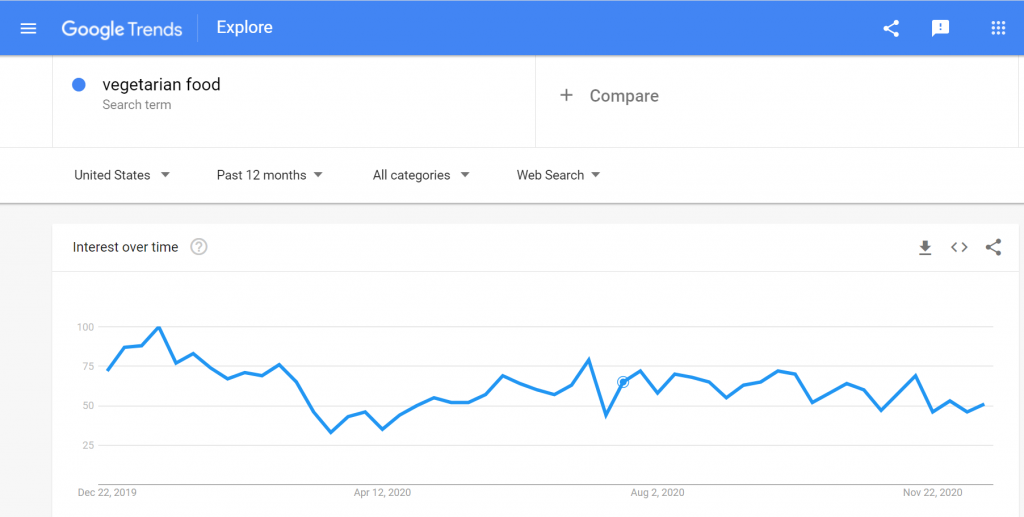
The U.S’ interest in vegetarian food has undergone a fluctuating decline throughout 2020.
If you opt for a small-scale business, it helps to ask around within your area, city, or county. Sometimes, small talks pave the way for great insights.
After understanding the market, you now need to evaluate your forte and skills.
- What cuisine are you good at cooking?
- Do you have any specialties that distinguish you from others? In the best perspective, your passion will match the current course of the market. If not, try to think about skills you should improve or resources you can take advantage of. As there are endless demands for all kinds of food, your products can be anything from cakes, cookies to baked dishes.
- For those who sell homemade goods, you should begin with your specialties for starting on the right.
Your business can be more successful if you define target customers clearly before selling anything. Are you going to target people with a healthy-eating lifestyle? Or are you planning to serve working professionals who have no time to cook? Basically, you must pay attention to the following points when creating a portrait of your target buyers: age, gender, location, income & profession, interests/hobbies.
The scale of your business also matters since it would require a lot more effort and skills to manage a large store than to run a small retailer. If you have a knack for cooking and want to sell what you love, an online store to deliver goods within your state or city is worth considering.
Last but not least, you will secure a place in a crowded industry by having a Unique Selling Point (USP). For example, FreshDirect nails its niche by offering fresh, quality, and organic food with “freshness” being its USP. Goods always arrive in peak condition with information about how long the food will stay fresh.

FreshDirect places freshness as its top priority and always goes to great lengths to prove it.
III. Branding and packaging
01. Branding
Branding is a critical part of a business because it helps your brand stand out from the competitors. Generally speaking, it is the process of creating a positive image of your business in the target customers’ minds. To succeed in this stage, you should take into account three main elements, including:
Brand promise: This is the statement about what you will always bring to the table. Try to think about what customers expect from you, what other brands have yet to offer them, etc. The case of Domino’s might amaze you. The company guaranteed to deliver their pizzas within 30 minutes and always adhered to such a promise, which helps Domino’s stand out as a brand with fast delivery.
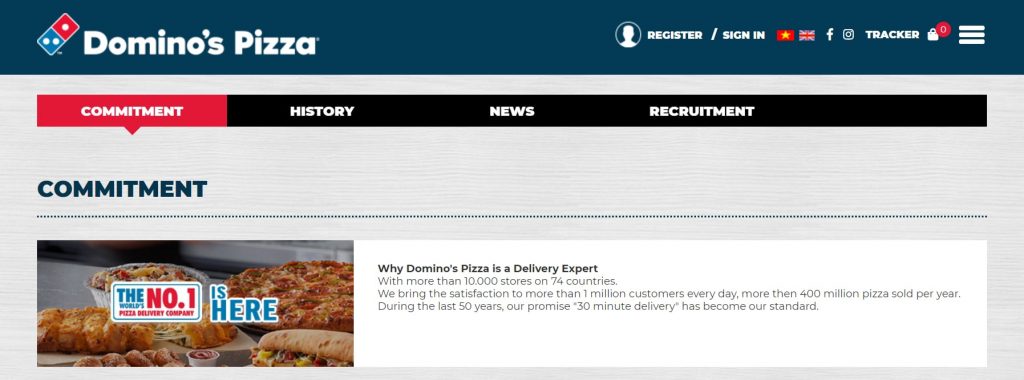
“30-minute delivery” is the commitment of Domino’s Pizza.
Brand characteristics: are the core values or personalities of your business. For example, the dominant brand trait of Coca-Cola was excitement, which is delivered consistently throughout campaigns like Share a Coke. Also, brand personality needs to be specific and unique to separate your business from other players. “Reliable” is a commonplace brand character, while “dedicated” is a more notable one.
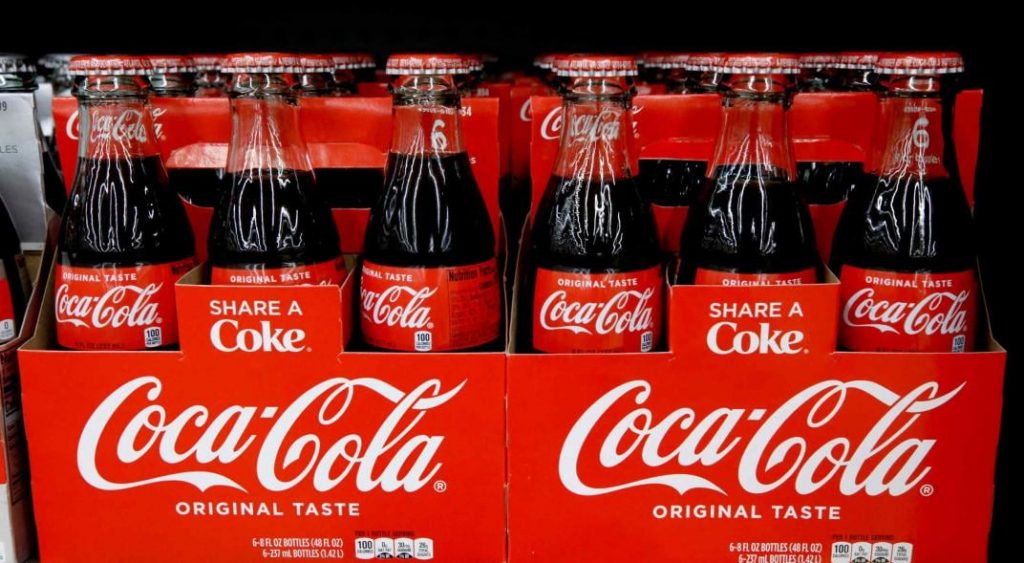
Red, which represents excitement, is the key color of Coca-Cola. The brand’s campaigns are always about parties and joyful moments.
Visual elements: are logo, key colors, typography, consistent style for images, etc. As you are going to sell food online, brand imagery is so important that it will create an impression on customers. In a nutshell, colors like red, yellow, and orange work best for the food industry because they trigger hunger psychologically. Avoid blue in your branding because it has the least effect on appetite, based on color theory.

The famous food brand KFC uses red for its logo and packaging.
02. Packaging
Selling food online is particularly challenging because customers can’t taste your products before buying. Hence, package design is critical as it helps buyers imagine how your food will taste. You can consider hiring a designer to create delicious-looking packages or boxes. Besides the visual appearance of your packaging, the details on it (i.e., labeling) is worth examining also. By reading the label, customers can know exactly the ingredients your goods contain. This information will help consumers with dietary restrictions avoid their risk of being allergic.
According to the Fair Packaging and Labeling Act, your goods should have labels with complete ingredients listed, total weight, net quantity, the name and location of the maker. When selling food online, keep in mind to highlight the following food allergens since they are the most common:
- Eggs
- Fish and shellfish
- Milk
- Peanuts
- Peanuts
- Soy
- Tree nuts
- Wheat
If you intend to ship food to other states, be sure to read those states’ labeling requirements carefully.
Below are the examples of packaging that trigger appetite at first look.

The package is orange, which is relatively the same as the cuisine’s color.

This transparent box did a good job! Has the yummy golden pie been covered, the item wouldn’t have looked that delicious.
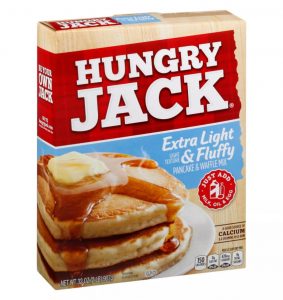
The close-up photo of fluffy melt-in-your-mouth pancakes makes you want to bite it.
IV. Sell Food Online With An eCommerce Website
You must have been longing for this section!
Selling food online using eCommerce website builders means you have total control of how your goods are displayed and seen. The task now doesn’t have to be difficult with smart eCommerce platforms, which allow you to stay home processing your business efficiently. Some best website builders to sell online are Ecwid, Square, Shopify, Wix, and WooCommerce.
In this article, we will focus on guiding you to open an online food store using Shopify.
First things first: Sign up for the trial period with Shopify. This allows you enough time to get used to the platform and build an online store from scratch.

Let’s take an overview of Shopify’s key features. When looking to the left of the admin channel, you’ll find a vertical list of items used for managing your store, from Home to Apps. Heading to Sales channels, the Online Store item here is about designing the website and arranging shown content. In general, beginners have four must-do tasks to set up a food store, which are:
01. Add key pages to your site
Whenever visiting a store site, you must always see the main menu bar placed on top with must-have sections like About us, Contact, FAQ, and Policy, which are known as key pages. In Shopify, you can create those pages by going to Online Store > Pages > Create a new page. When selling food online, background information such as the brand story, the owner’s name, location, or phone number is indispensable because it helps ensure your business is credible. You’d better launch your site only after such information is well-prepared.

02. Edit your payment & shipping settings
You may find this part a bit complex at first, but no worries, I’ll cover the most basic steps you need to go through below:
For payment
Step 1: Choose your payment provider by going to Settings > Payment
Step 2: Filling in your business & banking information
Step 3: Choose the payment options for your business (e.g., Visa)
Step 4: Set your payout schedule (daily, weekly, or monthly)
Step 5: Customize your store’s name appearing on customers’ bank statements
For shipment
Step 1: Pick a shipping strategy (e.g., free shipping, local delivery, real-time carrier rates)
Step 2: Set up your shipping zones
Step 3: Create conditional shipping rates (i.e., set specific rates according to certain conditions)
Step 4: Set real-time calculated shipping rates. It allows customers to choose their preferred service and cost.

03. Add the products you plan to sell
This part must be the most interesting to any seller! To add your items on Shopify, you will go to Products > Add products. There are some steps you must complete here:
Step 1: Write the product title & description. It will help customers know the taste and ingredients of your goods.
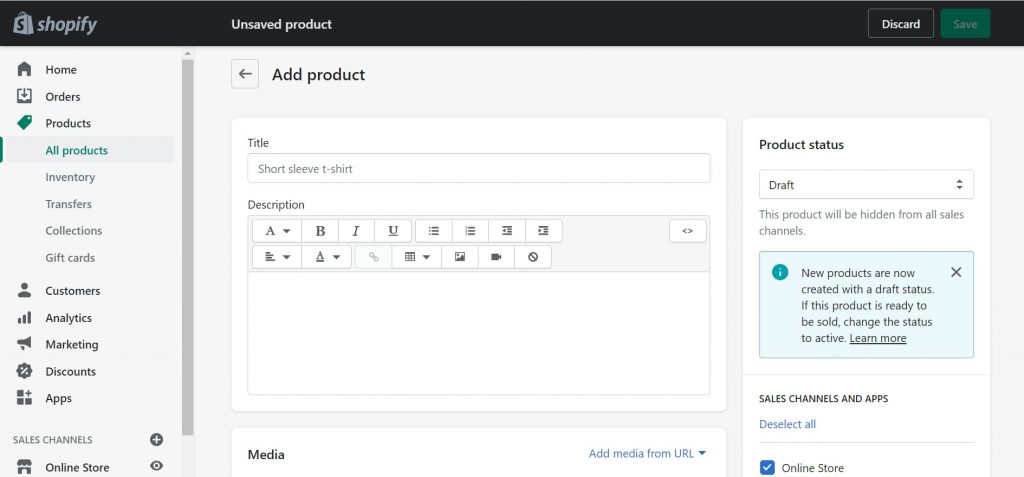
Step 2: Upload the product’s photo. Customers can’t make an offer without knowing how your good looks!
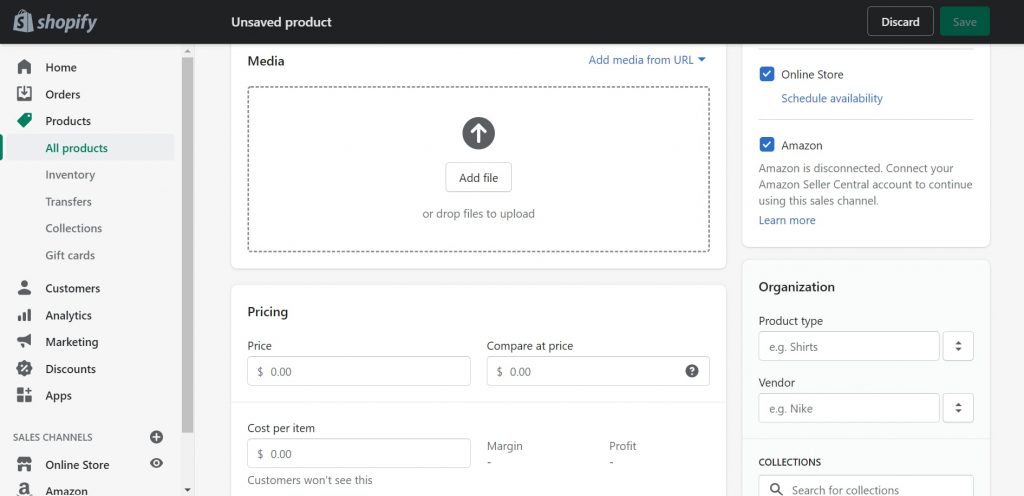
Step 3: Set the price. With Shopify, you can also track your profit margin by adding cost per item, which customers can’t see.
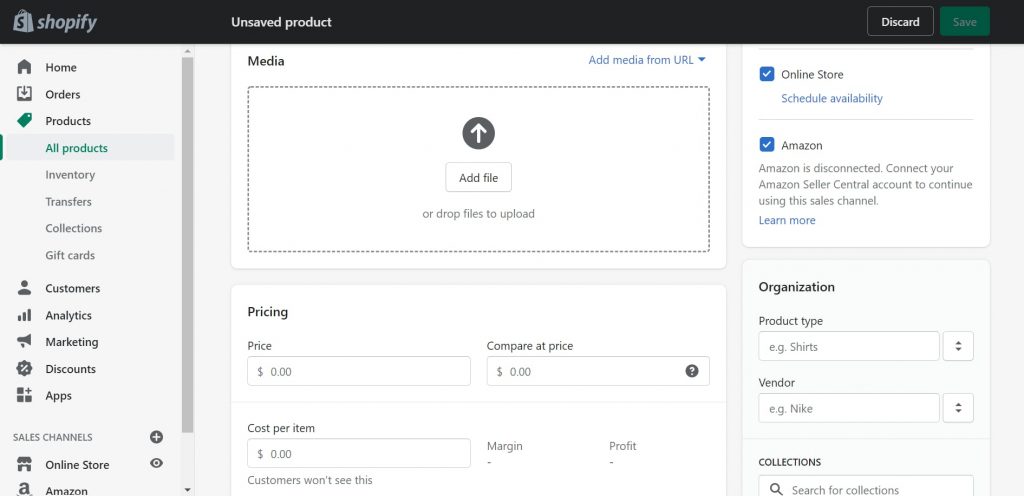
Step 4: Set up shipping. Here, you’ll add details that will automatically calculate the shipping cost and print the appropriate shipping labels for every order.

03. Choose a theme & customize
When you’ve finished with adding your main products, hesitate no more to make up your store site! You can pick a theme by going to Online Store > Theme. There is a wide range of well-designed templates, both free and paid, varying in styles and structures. The tip for selecting the right theme is to neglect colors & fonts (as you can customize them later) and focus on choosing the layout that best displays your items. After picking your theme, you can start customizing it to adjust things like the banner, footer, colors, fonts, images, etc.

Shopify has a collection of free themes that might suit you.
5. Sell your products on online marketplaces
People who find managing a separate online store time-consuming might go for the idea of selling on online marketplaces. E-commerce websites like Amazon or Etsy are the top-of-mind ones, which I will show you later. First, let’s make sure you are conscious of the pros & cons of this sales channel.
Pros
- Already has a large number of customers visit the site every day.
- You can gain trust and be recognized instantly (especially helpful for food businesses).
- No need to manage your website
- You don’t have to think about payment & shipping policies as they are well-prepared.
Cons
- It takes time for a new business to stand out in a crowded marketplace.
- Hard to build your brand identity without creative imagery.
- Not SEO-friendly for your brand and products.
- You have no control over customer analysis and CRM (customer relationship management).
Now, you must have an overall understanding of how e-commerce websites will benefit your online business. It’s time to look at some basics of setting up a new food store on an e-commerce platform. I will take Amazon, of which fastest-growing category is grocery (according to eMarketer), as a case.
Studying marketplaces’ regulations is the first thing you should do to choose an e-commerce website that fits you best. Amazon is known for its strict rules for the food & beverage category due to the nature of this industry. To get Amazon’s approval of selling in the F&B category, you must: register a selling plan, provide Amazon with the documentation of your goods, meet seller performance requirements, etc. Besides, there are also several certifications you have to prepare, especially for organic goods.
The packaging of your food product must meet Amazon’s requirement of packing and sealing. Amazon considers food products as date-sensitive, so an expiration date marked on every single unit is needed.
Online marketplaces also require you to pay a few fees. On Amazon, they are:
- Amazon referral fees: or commission Amazon takes from you. It depends on your category but ranges from 12% to 40%.
- Individual seller fee: If you sign up for an Individual Selling Plan, there will be $0.99 added to each sale on top of the referral fee.
- FBA fees: If you are in Amazon’s FBA program, you will have to cover the handling (preparing and sending goods) and shipping costs for Amazon. The fees rise as the items get bigger and heavier.
- Other Amazon fees: You may have to pay for inventory storage fees, media fees (apply for books, DVDs), and advertising costs.
Once you are relatively familiar with the marketplace’s policies, you can start creating your product list. Also, Amazon has a few requirements for the format and information displayed on the product detail page of food stores.
Other ideal candidates to take into account are:
- Walmart: Sellers who seek lower competition may find this e-commerce website fit perfectly. Walmart has about 33,000 sellers, while this number of Amazon is more than 2.5 million. Unlike Amazon, Walmart does not charge you monthly or initial setup fees. It also offers all preferred payment options, including credit cards, Paypal, Visa Checkout, Amex Pay, Chase Pay, etc. However, the website has strict pricing rules as it expects the sellers to offer the same products at the lowest prices in the online market.
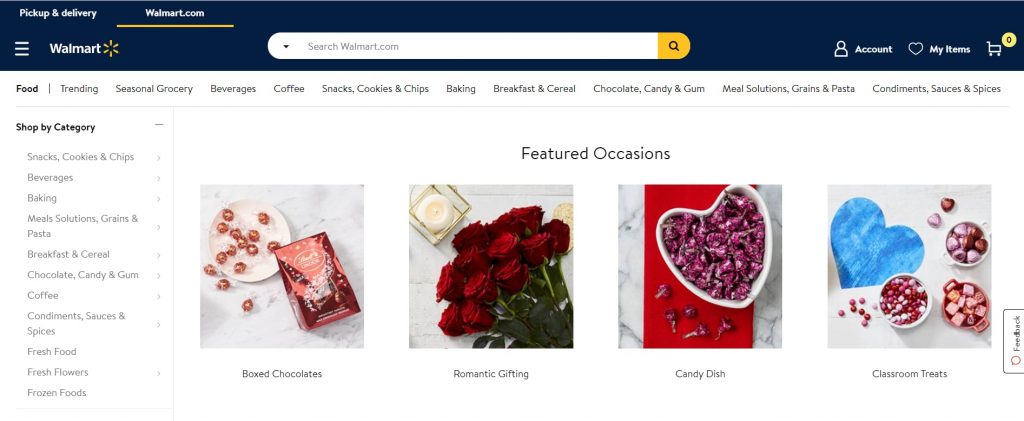
Walmart offers a wide range of food categories.
- Target.com: This website has around 250 million visits per month and allows selling various kinds of food (e.g., meat & seafood, frozen food, snacks & cookies, beverages). As a big name in the U.S, Target.com adheres to some values to place a product on its site, which means your store must meet specific standards to be present there. If you want to sell on this platform, you need to write a compelling proposal to prove your products outweigh other players in the field. Such an approach is likely to fit merchants with a solid idea.
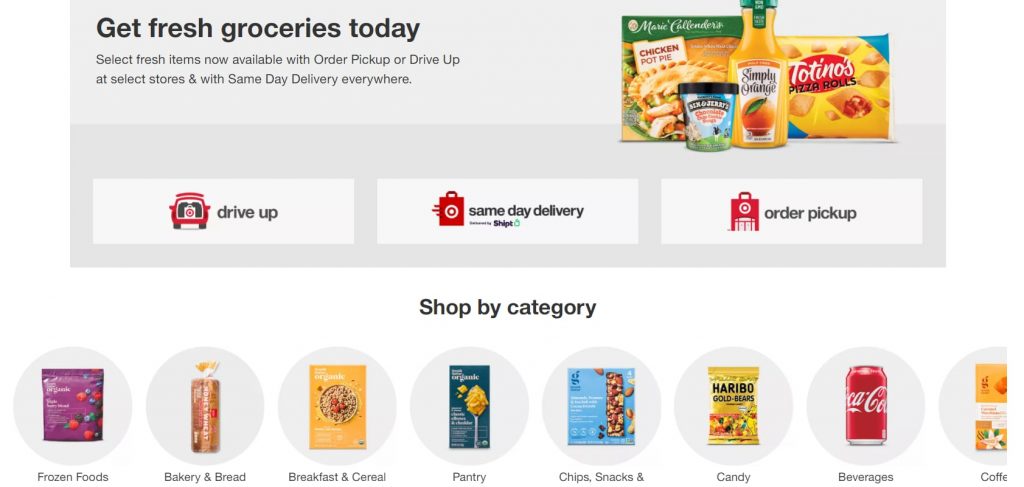
There are various food types on Target.com.
6. Market your food products
You’ve reached the last stage! Operating an online store has never been easy as it involves a sophisticated process called marketing. Generally speaking, it is a set of activities conducted to promote your products to target customers. There are various marketing strategies, but I will list the most impactful things you need to know.
SEO
SEO (Search Engine Optimization) is the practice of optimizing your website’s content to make the site appear on search engines like Google. The company has used many ways to rank websites in its search results, but the best tips are:
- Optimize store site for keywords: For example, if you sell homemade Italian pasta, you may have to integrate the word “Italian pasta” into your site. Recommended places are headings, title tags, meta description, and body text of your pages. However, overusing them may lead to a negative impact on your ranking. You’d better use keywords where they make sense.
- Earn backlinks: Backlinks are links to your website from credible sites. It helps Google verify your site is trustworthy and valid, resulting in a better ranking in search results. You will need to create content and invite authority sites to use it as their resources. The key is writing original, high-quality content so credible websites will find it of their interest.
- Content: Producing valuable content is undeniably a great way to win a higher ranking on Google search. It must be unique, answer the commonplace questions of customers, and contain keywords. For example, if your business is about cookies, relevant blog posts can be Cookies recipes for Christmas, Easy cookies recipes, Bake cookies in microwave, etc.
Learn more about SEO for online store HERE
Social Media
Social platforms like Twitter, Facebook, or Instagram have become increasingly significant in our daily life. According to Statista, the number of Facebook users in the U.S has reached 190 million in 2020.
It means you may miss millions of customers if not utilizing such powerful tools. Though marketing strategies vary, there are takeaways you should keep in mind:
- Visual is the key: How many times are you attracted to a tasty food video popping up on your newsfeed? It must be countless! Images and videos with delicious cuisines displayed is a must for marketing your products. Suitable platforms are Facebook and Instagram, especially the later one as it centers on photo & video sharing. To make your food look mouthwatering, what I recommend is using warm-toned filters and avoid cold (blue, white) tones.

Cookat is very successful for its food videos, which make viewers cannot take their eyes off.
- Customer feedback matters: Since online shoppers can’t taste your product, they need reviews from previous buyers to know what the food’s flavor is, whether it triggers allergy, how the quality is, etc. Posting consumers’ positive reviews on social platforms like Facebook is an old-but-old strategy to attract more customers for your business.
- Advertise if you can: Running advertisements is one of the fastest (but costly) ways to promote your online store. Facebook Ads allows you to target the right people by configuring audience options according to demographics, interests, and behaviors. Besides appealing imagery, the content shown in your ads needs to be engaging, concise, and specific.

- Everyone loves free stuff: It is easier to penetrate the market by offering your customers free or low-priced products. A pizza combo served half-price can urge people to make a purchase instantly. Engaging Facebook posts will bring you more traffic, better brand awareness, and even shoppers’ details, which is crucial for email marketing.
Email marketing
Email marketing is an effective strategy to acquire new customers and maintain relationships with them. It is also the face of your customer service. Remember, there are always other players in your field. What distinguishes you from competitors is the way you care about your purchasers. It could be: send personalized happy birthday emails to subscribers, show them your new amazing cooking recipes, wish them a happy new year with gifts enclosed, etc. Though email marketing is not new, not many businesses devote their heart and time to create quality and unique emails. If you do, you win.
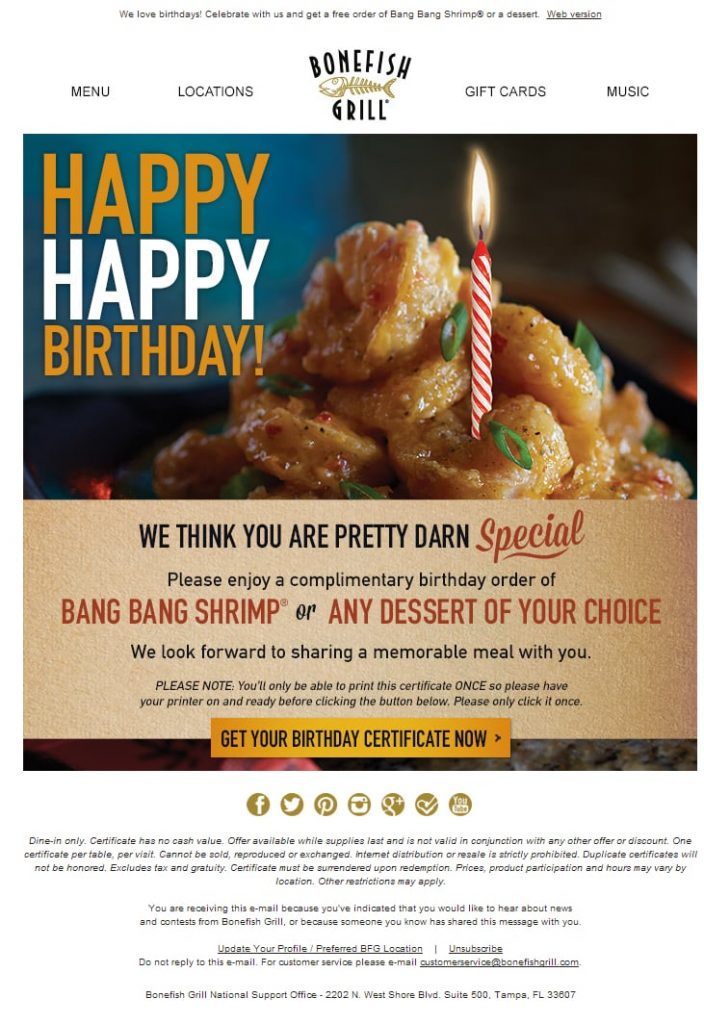
A happy birthday email from a food brand. (Pinterest)
Conclusion
I’ve just provided you with the main approaches to open an online food store. Though it takes time to get familiar with those ingredients, you will be ready to start selling soon. Now, it’s time to give it a go!
Check out other Brick-to-Click in-depth guides:
